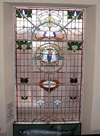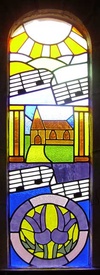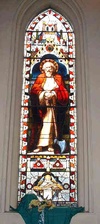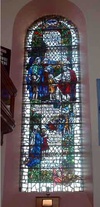A
| Aboyne Stained Glass, War Memorial |
|---|

An ornate memorial setting of stained glass and elaborate stone mullions flanked by the rolls of honour. The six allegorical figures are from left to right: Valour, Patriotism, Victory, Peace, Freedom and Justice. More Information |
B
| Banff Museum and Library |
|---|

Stained glass window, incorporating Banff town coat of arms. With its insignia of the Virgin Mary and plant motifs in the art nouveau style. More Information |
C
| Chapel of Garioch stained glass |
|---|

Chancel, window on theme of Sacrifice and Service; donated by Women's Guild, 1931. Shows the crucifixion with virgin and child above flanked by 2 Saints on either side. With smaller panels showing illustrations of biblical stories relevant to the theme. Text reads :"TO THE GLORY OF GOD AND IN MEMORY OF THE MEN AND WOMEN OF THIS CHURCH WHO LOVING THEIR LORD SERVED HIM IN LIFE AND DEATH." |
| Church of the Immaculate Conception , various architectural decoration, windows and, soup kitchen |

The Church of the Immaculate Conception is the last remaining place of worship in Stonehaven's Old Town. It boasts details recognised as deriving from Notre-Dame-le-Grand, Poitiers and Chartres and despite the loss of some original glazing is nevertheless an important quiet place on its island site surrounded by roads and behind the High Street. The building date varies from 1875 to 1879 depending upon the source, but it is a certainty that funds for this fine church and the nearby Rickarton Cottages were provided by Mrs Eliza Maria Hepburn of Rickarton, as a memorial to her daughter. A sketch in Christie's 'Haven Under The Hill', entitled 'Church of St Mary' shows decorative ridge detail and a ship weathervane, neither of which are evident today (2004). He also mentions an American organ which was installed in April 1880. The priest´s house is located at the nearby (separately listed) Rickarton Cottages and is accessible from the church grounds. The nearby soup kitchen was presented to the church by George Blackie in 1905. |
E
| Elizabeth Mantell Stained glass Memorial Windows |
|---|

A set of three stained glass windows produced in memory of missionary nurse and Macduff resident Elizabeth B Mantell 1941-1998. The windows which combine old and new Celtic and African art. A centre panel of hand painted sections display a portrait of Elizabeth Mantell nursing a child, the Macduff Parish Church and the Mulanje Mission Hospital in Malawi, where she developed high quality nursing and midwifery over a period of 14 years. The side panels combine the Saltire Cross and the Malawi flag. Traditional Celtic border.Elizabeth mantell was born in Africa, where her father was an agent of the African lakes, In 1952 the family moved to Macduff where she grew up. More Information |
| Ellerslie - door, ironwork & stained glass |

House dated 1892, altered and extended. 2-storey, 5-bay, rectangular-plan, end terrace house (sub-divided) with keystoned and pedimented moulded door-piece, tall round-arched stair window with decorative astragals and coloured glass (the round medallions containing portrait heads) and some fine interior detail; on ground falling to S and E. Painted ashlar with ashlar margins, quoin strips and base course to W; ashlar with 1st floor cill course and eaves cornice to E. |
S
| Skerryvore stained glass door panel |
|---|

A domestic stained glass door panel depicting a lighthouse and seascape with gulls and a passing trawler. More Information |
| St James the Great, Episcopal Church Stonehaven, stained glass |

STAINED GLASS: some fine coloured glass, including apsidal window depicting 'Christ crucified' by Clayton & Bell of London, flanked by windows depicting on left, the carrying of the cross and the flagellation, and on right the descent from the cross; West window is a memorial to Dean Christie showing 'Christ's Baptism' and 'Baptism from the Tolbooth window' (this illustrates the Rev. Alexander Greig baptising infants from the Tolbooth window while imprisoned in 1748 by the Hanoverian authorities for holding a service attended by more than 5 persons); memorial windows to nave including 'The Good Samaritan' commemorating Leslie Thomson and family of Invercowie House, 'St James' memorial to the Adams Family (1832-1955), and 'Angel' in memory of Alexander Innes of Raemoor, died 1882. Sir Ninian Comper's baptistery windows commemorate David MacDonald, headmaster of Episcopal school. |
| Stained Glass Windows |

The architect was Archibald Simpson 1833-34. Tudor gothic style. Listed category B. More Information |
W
| War Memorial Stained Glass Window |
|---|

Two stained glass windows dedicated to the Glory of God and in memory of the men of the congregation who lost their lives in the First World War 1914-1919. The window on the east side of the pulpit is based on the text "This is the victory that overcometh the world, even our faith," 1 John v., 4. The window on the west side is known as the Children's Window, the theme of this window is the text "Suffer little children to come to unto me, and forbid them not, for such is the Kingdom of Heaven." The Children's window is an especially fine piece of work and had the distinction of being shown in the Royal Academy, London, prior to its installation. Windows signed CW or WC in monogram form. More Information |
| Weavers Cottage Stained glass House Door |

A contemporary front door with four inset stained glass panels forming a harbour landscape in naive style More Information |
This content was submitted by external contributors and does not necessarily reflect the views of the University of Aberdeen.
